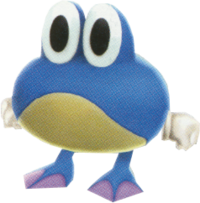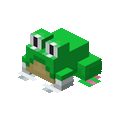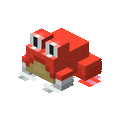Kleptoad
- Not to be confused with Klepto.
| Kleptoad | |
|---|---|
 Artwork from Super Mario Galaxy 2 | |
| First appearance | Super Mario Galaxy 2 (2010) |
| Latest appearance | Minecraft: Bedrock Edition (The Wild Update) (2022) |
Kleptoads[1] are enemies in Super Mario Galaxy 2. Their name is possibly a portmanteau of "kleptomania" (like Klepto's name), a mental illness where a person has an uncontrollable urge to steal things, and "toad," referring to their appearance. These blue frog-like creatures are encountered in Hightail Falls Galaxy during the Silver Stars in Hightail Falls mission only. They jump and also burrow into the ground and appear out of a random spot similar to Gobblegut. Sometimes, they have a type of item above their heads and try to keep it by jumping. When an item is on the ground, they might pick up the item and try to keep it. Also, if one gets defeated, another tries to pick the treasure up. They can be defeated by having Yoshi eat them or jumping on top of them.
In the Super Mario Mash-Up Pack in Minecraft, Frogs are replaced by Kleptoads.
Appearances
 marks missions where they are completely absent.
marks missions where they are completely absent. marks missions where they are loaded and may be visible, but cannot be encountered directly.
marks missions where they are loaded and may be visible, but cannot be encountered directly.
| Worlds | Galaxies | Missions | ||
|---|---|---|---|---|
| World 2 | Hightail Falls Galaxy | |||
Gallery
Names in other languages
| Language | Name | Meaning | Notes |
|---|---|---|---|
| Japanese | ニゲーロ[2] Nigēro |
Portmanteau of「逃げろ」(nigero), the imperative form of「逃げる」(nigeru, to escape), and「ゲロゲロ」(gero-gero, onomatopoeia for a frog's croaking) | |
| French | Croapule[?] | From the onomatopoeia croa (frog's croak) and crapule (villain) | |
| German | Blunkel[?] | - | |
| Italian | Marrana[?] | Portmanteau of on marrano (an old-fashioned name for criminals) and "rana ("frog") | |
| Spanish (NOE) | Terrana[?] | Possibly a portmanteau of terra ("land/earth" for Latin) and rana ("frog") |
References
- ^ Browne, Catherine (May 23, 2010). Super Mario Galaxy 2: PRIMA Official Game Guide. Roseville: Random House Inc. ISBN 978-0-30746-907-6. Page 27.
- ^ Sakai, Kazuya (Ambit), kikai, Akinori Sao, Junko Fukuda, Kunio Takayama, and Ko Nakahara (Shogakukan), editors. (October 19, 2015). 『スーパーマリオブラザーズ百科: 任天堂公式ガイドブック』. Tokyo: Shogakukan (Japanese). ISBN 978-4-09-106569-8. Page 160.



